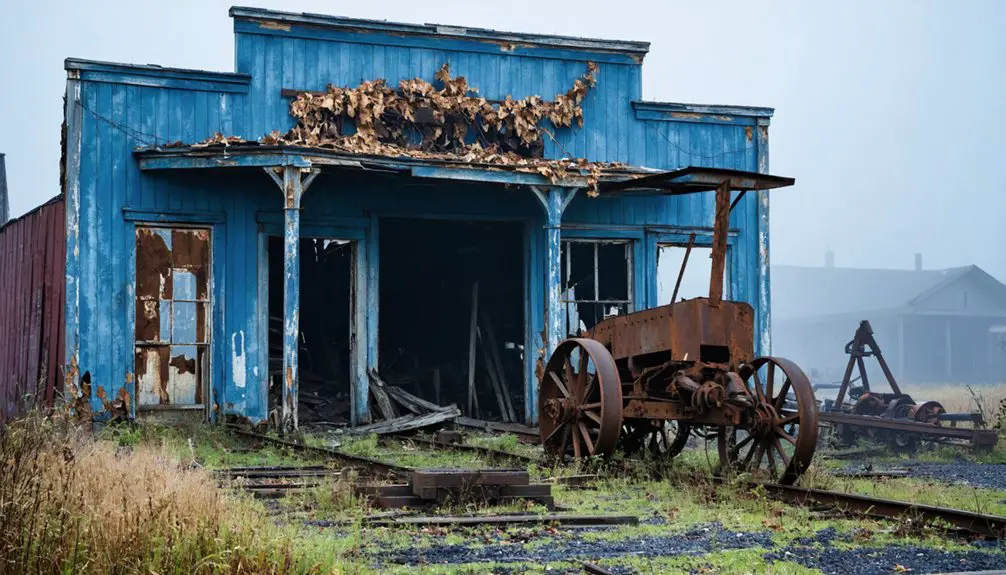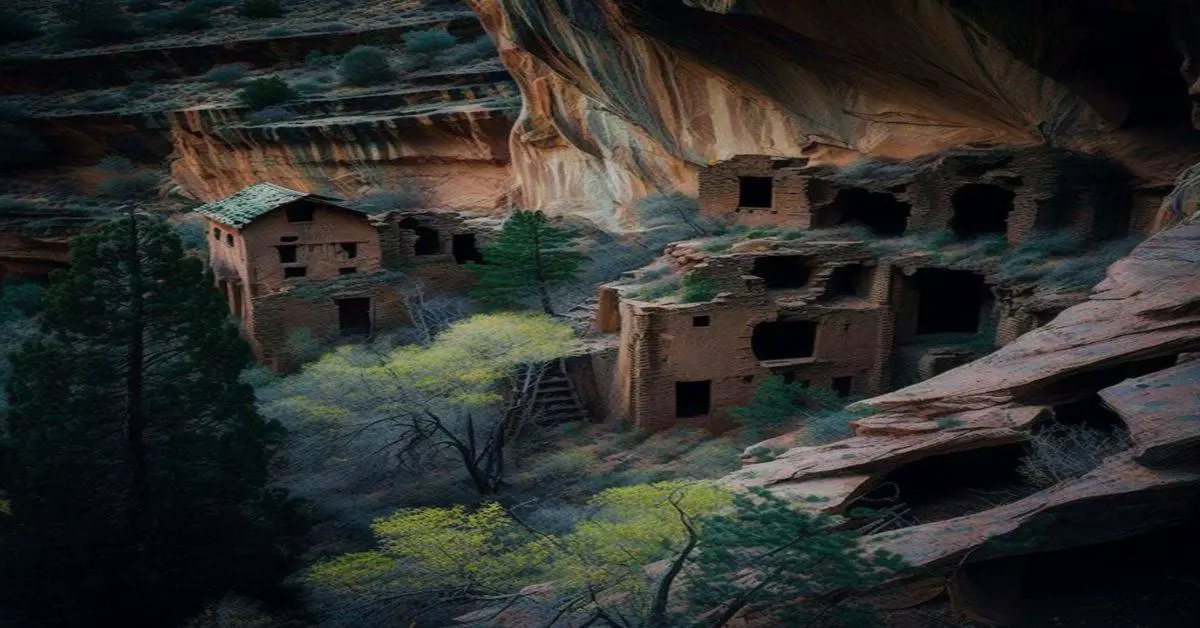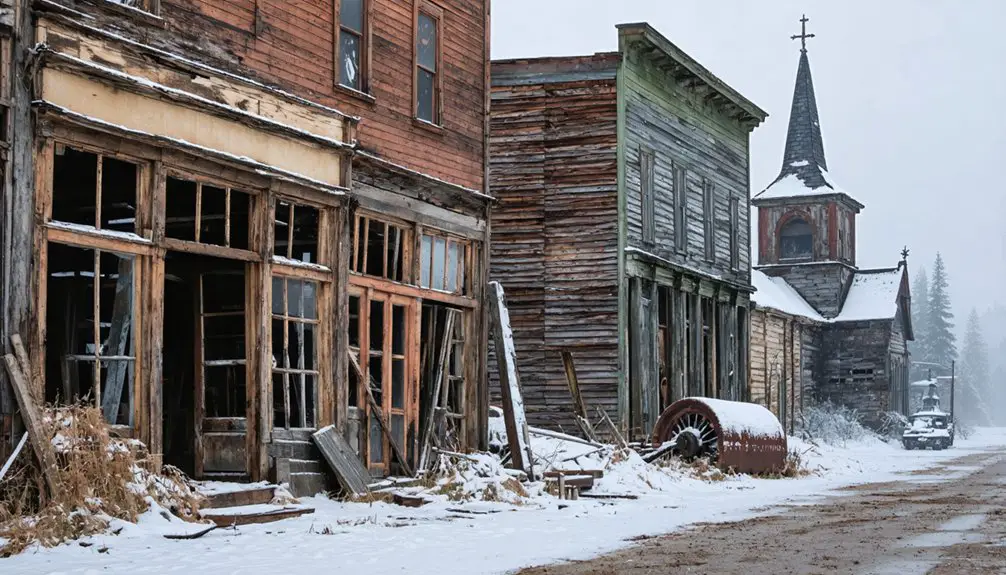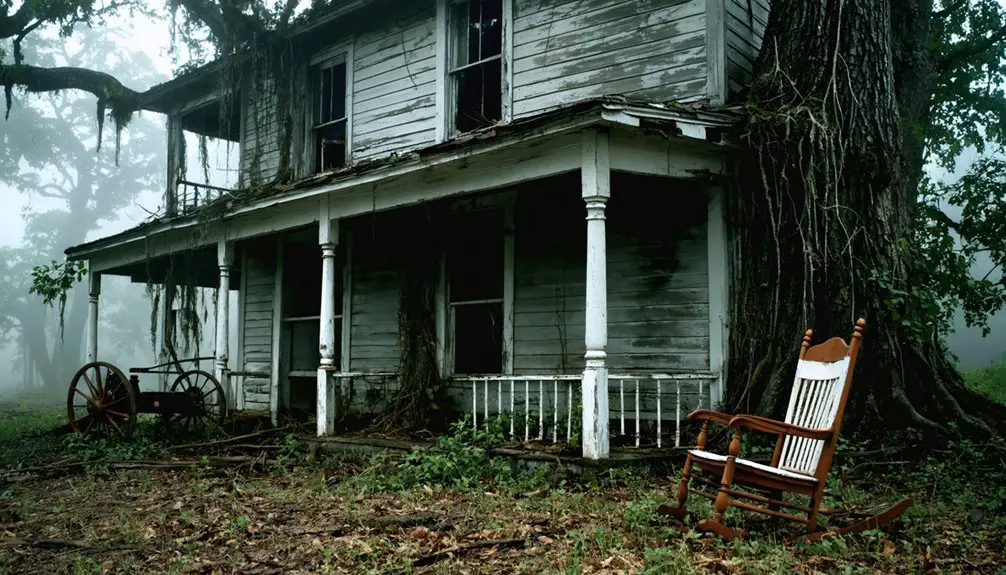You’ll find Whitney’s haunting ruins in Raleigh County, West Virginia, where abandoned mine shafts and crumbling company houses stand as silent witnesses to a once-thriving coal town. During its peak in the early 1900s, this company-controlled community provided workers with housing, stores, and basic services, all paid for with company scrip. Today, Whitney’s weathered foundations and scattered artifacts offer glimpses into the complex story of Appalachian coal mining’s rise and dramatic decline.
Key Takeaways
- Whitney, WV, transitioned from a bustling coal mining town to a ghost town following the decline of the coal industry.
- Company-owned housing, stores, and facilities were abandoned when the mines closed, leaving deteriorating structures behind.
- Infrastructure remnants include crumbling foundations, artifacts, and ruins that showcase early 20th-century coal town life.
- Economic collapse forced residents to leave company-owned homes in search of employment elsewhere, creating mass outmigration.
- The ghost town preserves cultural heritage through physical remains while illustrating the devastating impact of industrial decline.
The Rise of a Coal Mining Community
While coal’s presence in West Virginia was known as early as 1742 when John Peter Salley spotted outcroppings along the Kanawha River, the region’s transformation into a thriving mining hub didn’t begin until the mid-1800s.
You’ll find that community growth exploded after the Civil War, especially in counties like Mineral, Monongalia, Marion, and Fayette, where rich coal seams attracted major operations. Coal companies established company-controlled settlements near the mines, providing housing and stores for their workers.
The arrival of railroads in 1883 revolutionized the industry, enabling mines to ship nearly 3 million tons of coal that year alone.
Railroad expansion in 1883 marked a turning point, as mines could now transport millions of tons of coal efficiently.
This mining heritage shaped the landscape as companies established towns around the rail lines, particularly in southern coalfields like the Flat Top-Pocahontas Field in Mercer and McDowell counties, where commercial shipments began transforming rural areas into bustling mining communities. The region’s development accelerated when salt furnaces adopted coal in 1817, marking an early industrial transition from traditional fuel sources.
Life in a Company-Controlled Town
Although coal companies rapidly constructed entire towns near their isolated mines, these settlements represented far more than mere housing developments – they were calculated systems of control.
You’d find yourself living in identical company-owned housing, shopping at the company store with scrip instead of real currency, and watching your every move scrutinized by company officials. Your children would attend company schools, and you’d worship in company churches, all designed to reinforce company values and maintain social order.
Workers faced low wages and poor conditions while being completely dependent on their employers for basic necessities. The company control extended deep into daily life, with surveillance aimed at preventing union activities. You couldn’t escape their influence – they owned everything from your water supply to your entertainment venues.
These carefully crafted social dynamics created communities where your family’s survival depended entirely on staying in the company’s good graces. During economic downturns, the mass migrations of workers and their families devastated these company-dependent communities.
Daily Operations and Mining Activities
You’d have found Whitney’s underground mines equipped with basic tools like picks, shovels, and hand drills, which miners used during long shifts in dark, cramped tunnels illuminated only by safety lamps.
Working conditions were harsh as you contended with poor ventilation, coal dust, and the constant threat of methane gas buildup, while moving through passages supported by wooden timbers. The dangerous environment contributed to West Virginia having more mining deaths than any other state during this era.
At shift changes, you’d gather your equipment at the mine entrance, where supervisors tracked worker attendance and guaranteed safety lamps were properly maintained before crews descended into the mine shafts.
Mine Equipment and Tools
The evolution of mining equipment in Whitney transformed daily operations from manual labor to mechanized efficiency. You’d have seen dramatic mining technology changes as electric cutting machines replaced picks by 1890, while mechanical undercutting tools eliminated backbreaking manual work by the early 1900s.
The equipment evolution accelerated when loading machines took over from hand shoveling in the 1920s. Cable-reel locomotives eventually replaced mules for secondary haulage tasks in this period. During World War II, the coal industry saw major advancements in foreign competition that drove equipment innovations.
Underground transport underwent revolutionary changes too. Electric trolley locomotives replaced mule teams, while conveyor belts and shuttle cars moved coal faster after 1936.
Surface operations benefited from powerful draglines and shovels introduced in 1914. Power sources shifted from steam to electricity, enabling more efficient machinery throughout the mine.
These advances dramatically increased production while reducing the physical toll on miners.
Underground Working Conditions
Deep beneath Whitney’s surface, miners endured harsh working conditions while extracting coal from narrow tunnels during grueling 10-12 hour shifts.
You’d find them drilling and blasting through coal seams, loading heavy carts by hand, and setting timber supports to prevent deadly cave-ins. Underground hazards lurked constantly – methane gas buildups could trigger explosions when sparked by lanterns, while flooding and roof collapses posed ever-present threats.
Ventilation systems, required by law since 1883, attempted to clear dangerous gases and dust, but primitive monitoring meant deadly conditions often went undetected.
You wouldn’t find modern safety equipment here – just basic tools and flame safety lamps to warn of toxic gases. Miners worked at a frantic pace, paid by the ton, which only increased their risk of accidents in these treacherous tunnels.
Shift Change Procedures
As dawn broke over Whitney’s coal camp, miners gathered at the surface checkpoints for the intricate shift change ritual that kept the mine operating around the clock.
You’d find outgoing crews handing over detailed reports about mine conditions, equipment status, and any hazards they’d encountered during their shift. The strict shift change protocols required you to gear up with safety equipment while supervisors tested communication systems and reviewed production goals.
Before heading underground, you’d attend mandatory safety briefings where they’d warn about explosive gases, roof conditions, and emergency procedures.
Every piece of machinery, from coal cutters to conveyor belts, underwent thorough inspection. Time cards were punched, logs were updated, and canaries were checked – all part of Whitney’s relentless 24-hour mining operation that powered America’s industrial might.
The Economic Impact on Local Families

Living in Whitney, West Virginia meant total reliance on coal mining for survival, as families depended on the industry for everything from wages to housing.
When mines closed, you’d witness immediate economic struggles rippling through the community, forcing widespread family displacement as workers sought jobs elsewhere. Many families had to leave behind their company-owned houses, since the buildings belonged to the mining operations.
The state has seen employment decline from over 100,000 miners to fewer than 20,000 today. You’d see household incomes plummet from well-paying mining positions to unemployment or lower-wage work. The impact wasn’t just financial – your community’s health deteriorated, with increases in heart disease, diabetes, and devastating opioid abuse.
Your children likely moved away, contributing to Whitney’s aging population and declining services. Even with coal’s slight rebound in 2021-2022, the deep-rooted economic damage persists, leaving families with limited options for recovery in this former company town.
Infrastructure and Essential Services
While coal companies maintained Whitney’s basic infrastructure during its operational years, you’d find the town’s crucial services were deliberately sparse and company-controlled. Your daily needs relied entirely on company-provided utilities, from coal-fired heating to minimal electrical service. Similar to Kaymoor mining complex, the town’s infrastructure was built deep into the gorge.
Water quality often suffered from mine runoff, while sanitation issues plagued the rudimentary sewage systems.
Mine waste tainted local water sources, while basic sewage infrastructure struggled to maintain even minimal sanitation standards.
Crucial services in Whitney included:
- A basic water supply drawn from local creeks and wells
- Coal-powered heating and limited electricity to key buildings
- Unpaved roads connecting to the crucial railroad lines
When mining operations ceased, Whitney’s infrastructure quickly crumbled. You’d see abandoned rail tracks, deteriorating buildings, and defunct utility systems.
Without company maintenance, the town’s crucial services vanished, leaving residents with little choice but to seek opportunities elsewhere.
Cultural Heritage and Social Dynamics
Through the late 19th and early 20th centuries, Whitney’s social fabric reflected the complex dynamics of an Appalachian coal mining community.
You’ll find traces of cultural preservation in the town’s remaining structures, which tell stories of diverse immigrant workers who shaped local traditions through their music, crafts, and storytelling.
The community’s resilience emerged through its social institutions – churches, schools, and informal gathering spaces where residents forged strong bonds despite their often transient existence.
You can still witness this heritage in preserved buildings and collected oral histories.
While many residents didn’t own land, they built a vibrant social life centered around boarding houses and communal spaces.
The town’s cultural legacy lives on through the National Park Service’s preservation efforts, allowing you to experience Whitney’s rich mining-era heritage firsthand.
The Decline of Whitney’s Coal Industry
When Whitney’s coal mines shuttered amid the massive regional decline in coal production, you could witness firsthand the town’s rapid economic disintegration that mirrored West Virginia’s broader industry collapse.
The closure left hundreds of local miners without work, reflecting the state’s pattern where coal employment plummeted by 54% between 2005 and 2020.
You’d have seen entire families pack up and leave Whitney in search of work elsewhere, transforming this once-bustling mining community into another casualty of Central Appalachia’s shifting energy landscape.
Mine Closure Economic Impact
Despite having over 27 million tons of recoverable coal reserves that could’ve sustained operations for three decades, Core Natural Resources’ permanent closure of Whitney’s coal mine dealt a devastating blow to the local economy.
You’ll find that the shutdown’s ripple effects challenged the region’s economic resilience, as 234 workers lost their jobs and local businesses dependent on mining operations struggled to survive.
- The immediate loss included 197 miners and 37 coal preparation plant workers, devastating families who’d relied on these stable jobs.
- Whitney’s metallurgical coal production, essential for steel manufacturing, tied the town’s fate to volatile global markets.
- Community adaptation proved difficult as reduced tax revenues crippled municipal services, while the lack of industry diversification left few alternatives for displaced workers.
Workforce Mass Exodus
The catastrophic decline of Whitney’s coal industry triggered a massive workforce exodus that would reshape the town’s demographic landscape forever.
You’d have witnessed the stark reality as employment plummeted by 54% between 2005 and 2020, with workforce migration accelerating as mining jobs dropped from over 100,000 to fewer than 20,000.
The economic challenges hit every sector – from retail to construction, creating a devastating ripple effect throughout the community.
Young residents fled in search of opportunities elsewhere, leaving behind an aging population struggling with mounting health issues and opioid abuse.
What you’re seeing now reflects the harsh aftermath of this exodus: shuttered businesses, depressed local economies, and one of the lowest life expectancy rates in America.
The town’s demographic makeup shifted dramatically as the workforce dispersed, leaving Whitney a shadow of its former self.
Remnants and Ruins Today
Standing silently in Fayette County, Whitney’s remnants paint a haunting portrait of Appalachian coal town abandonment.
Today, you’ll find the site largely reclaimed by nature, though ghost town exploration reveals telling traces of its mining heritage. The New River Gorge National Park helps guarantee remnants preservation while allowing you to witness this slice of coal camp history.
- Crumbling foundations and weathered ruins of homes, company stores, and mining structures peek through encroaching vegetation
- Scattered artifacts like rusted tools, mining scrip, and household items tell stories of daily life in early 20th-century coal camps
- Mine shaft entrances, tailing piles, and altered terrain stand as stark reminders of the industry that once dominated this landscape
While accessible, many structures remain fragile, offering a delicate balance between exploration and conservation.
Legacy in West Virginia’s Mining History
While many coal towns faded into obscurity, Whitney’s legacy endures as a tribute to West Virginia’s transformative mining era of the late 19th and early 20th centuries.
You’ll find Whitney’s mining significance woven into the fabric of West Virginia’s rise as a national coal producer, where over 60 mineable seams supported countless communities like it.
Whitney’s legacy reflects the struggle for workers’ rights, as miners fought against oppressive company control and dangerous conditions.
They faced violent opposition from the Baldwin-Felts Detective Agency and battled for unionization amid ethnic tensions.
The town’s story mirrors the broader narrative of Appalachian mining communities – places where immigrant and African American laborers built close-knit societies while enduring economic hardship and safety risks that would eventually spark significant reforms in mine safety regulations.
Frequently Asked Questions
What Was the Peak Population of Whitney During Its Most Prosperous Years?
You’ll find Whitney’s history and demographics aren’t precisely documented, but based on similar coal towns in West Virginia’s New River Gorge, its peak population likely ranged between several hundred to 1,000 residents.
Are There Any Known Photographs of Whitney From Its Operating Years?
You won’t find many publicly available photos from Whitney’s operating years, though historical archives and local collections might hold undiscovered images captured through early photography techniques of the coal mining era.
Which Specific Coal Company Owned and Operated the Mines in Whitney?
You’ll find the New River Coal Company controlled all mining operations at this location, establishing their dominance in Fayette County during the late 1800s through their extensive coal extraction activities.
Were There Any Major Mining Accidents or Disasters Recorded in Whitney?
Ever wonder about mining tragedies that shaped communities? While historical records don’t explicitly document major accidents in Whitney, you’ll find West Virginia’s mining safety archives focus on larger disasters in surrounding counties instead.
Can Visitors Legally Explore Whitney’s Remaining Structures and Ruins Today?
You can’t legally explore these ruins without explicit exploration permits, as private property laws and legal restrictions prohibit unauthorized entry. Always obtain permission from landowners before attempting any visits.
References
- https://kids.kiddle.co/List_of_ghost_towns_in_West_Virginia
- https://www.youtube.com/watch?v=-EeLwLa2t90
- https://www.tiktok.com/discover/towash-ghost-town-under-lake-whitney-txtext=theres-a-whole-town-buriedthe-water-level-goes-down
- https://en.wikipedia.org/wiki/Whitney
- https://en.wikipedia.org/wiki/List_of_ghost_towns_in_West_Virginia
- https://minesafety.wv.gov/historical-statistical-data/mining-in-west-virginia-a-capsule-history/
- https://www.wvgs.wvnet.edu/www/geology/geoldvco.htm
- https://energyhistory.yale.edu/coal-mining-and-labor-conflict/
- https://www.richmondfed.org/publications/research/econ_focus/2023/q3_economic_history
- https://theclio.com/entry/47848



